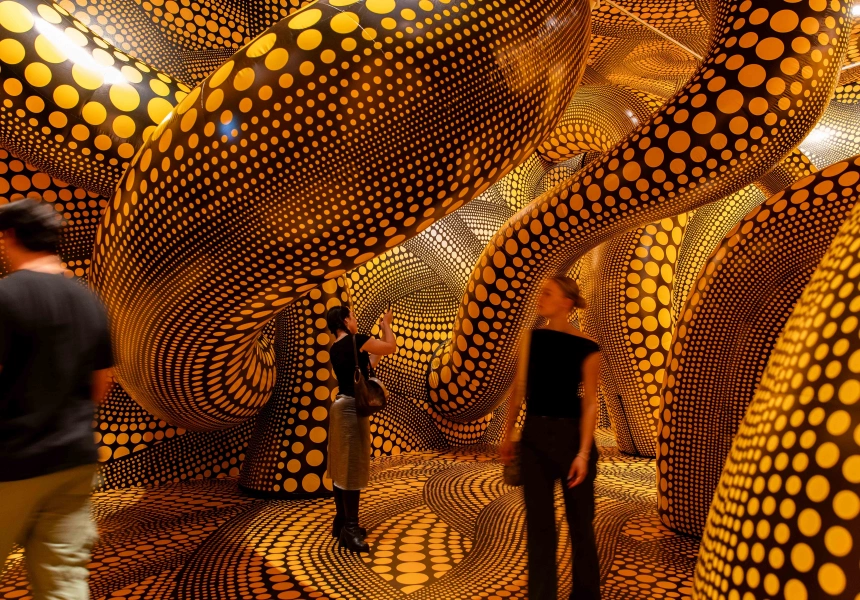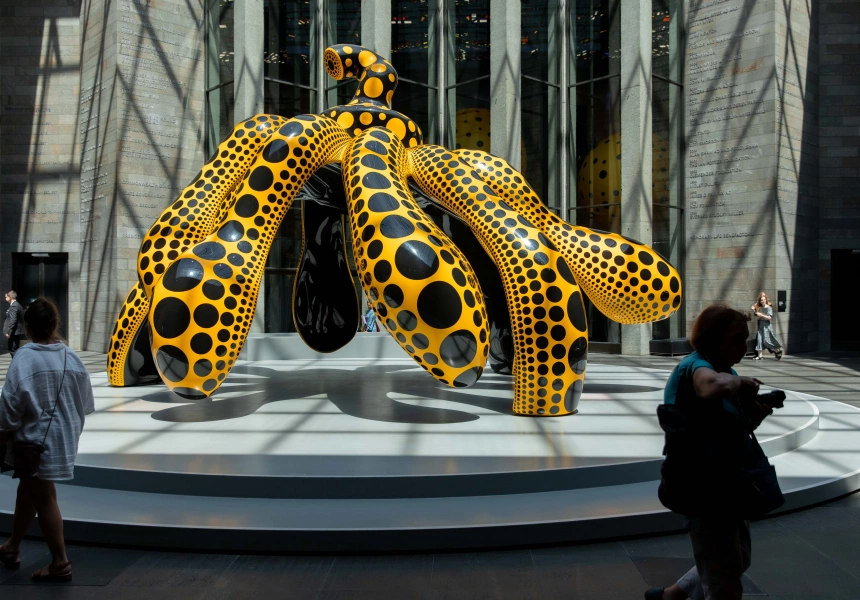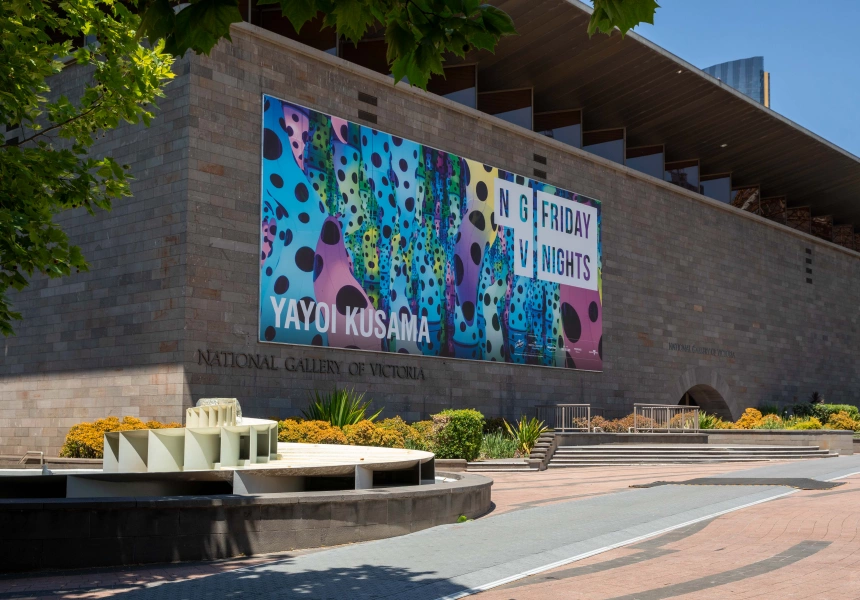The first work you’ll see upon entering the NGV’s blockbuster Yayoi Kusama exhibition is also the artist’s earliest: a double-sided sketch she did as a 10-year-old in Matsumoto, Japan. On one side, there’s a woman in a kimono; on the other, a vase holding flowers; and layered over both is the first sighting of the dots that came to define her career.
The comprehensive retrospective – the largest of Kusama’s work ever mounted in Australia – traces the evolution of her signature polka dots: from those early days in Japan on the family’s seed farm, to the Infinity Net paintings (abstract works featuring obsessively layered loops and specks) that made a splash in New York in the late 1950s and 1960s, all the way to the immersive, mirrored infinity rooms and spotty inflatables that have made her a global icon.
“When you see her infinity rooms in isolation, I think you could get a misrepresentation of Kusama as someone who churns out these aesthetically pleasing rooms that provide merely an opportunity for a selfie,” says Meg Slater, NGV’s curator of International Exhibition Projects. “But you can see that the principles that underlie those rooms are the same ones that have always been there from the very beginning.”
We think you might like Access. For $12 a month, join our membership program to stay in the know.
SIGN UPThe repetitious forms and patterns in Kusama’s work were spurred by the vivid hallucinations she’s experienced since early childhood. (The 95-year-old artist has voluntarily lived in a psychiatric institute since 1977.) “Creating art is really a form of therapy for her,” says Slater. “From a very early age she wanted to give form to what she was experiencing and what she was seeing.”
The sensorial exhibition, which takes over the entire ground floor of the gallery, features more than 180 works from her eight-decade career, gathered from the artist’s personal collection and major institutions across Japan and Australia. Among them is the global unveiling of a brand new infinity room, a kaleidoscopic space of dazzling, discombobulating light and mirrors; a new iteration of Narcissus Garden, an installation of more than 1000 silver mirrored balls Kusama famously staged – unofficially – at the 1966 Venice Biennale; and the Australian premiere of her 2019 work The hope of the polka dots buried in infinity will eternally cover the universe, which immerses you among six-metre-high inflatable yellow-and-black twisting tendrils.
It’s every bit as fanciful as you’d expect a Yayoi Kusama exhibition to be – but as spectacular and enthralling as her playground-like installations are, some of the most striking moments are in her lesser-known works: her hypnotic paintings, the eyebrow-raising sculptures she made in New York’s avant-garde scene, and her radical fashion pieces (what Slater describes as “peekaboo clothing” and “orgywear” with “holes cut out in strategic locations”).
“That’s what’s so special about the show, in my opinion: I think people have a particular idea of what Kusama’s work is like or that she’s a one-trick pony, but she’s really not,” says Slater. “She has worked across so many media and intersected with so many different ideas. It’s unbelievable. As you’re walking through, there’s obvious continuity in the visual forms and in the concepts, but if you were looking at just the diversity of media alone, it looks like it’s a show of 20 artists.”
These days, the self-appointed “high priestess of polka dots” is renowned for her singular and idiosyncratic use of pattern, colour and symbols to create immersive and intensely personal works of art. But she’s also made indelible marks on key art movements of the 20th and 21st centuries, including minimalism, pop art and feminist art – despite always forging her own unique path.
“Her work is extremely personal because she has never belonged to a movement or particular group in art history – she sort of distanced herself from that. She’s always had this incredible ability to look ahead and look back, and in doing that forged an incredible, singular sort of path that is rare to see.”
The two-part exhibition is a phenomenal display of breadth from an artist known so singularly for her immersive and larger-than-life installations. It also traces the consequential moments in Kusama’s life, including her period of “rebirth and renewal” in the ’70s after facing two significant losses and a period of isolation, and her return to the Venice Biennale in 1993 – this time as an invited participant.
“That really signalled her as an artist to be remembered for the groundbreaking works she made in the ’50s and ’60s,” says Slater. “But also put her back on the map as a leading contemporary artist today, and from that point on her ascent has been kind of exponential.”
Yayoi Kusama opens at NGV International from December 15, 2024, until April 21, 2025. Find more information and get your tickets at ngv.vic.gov.au.
Broadsheet is a proud media partner of the National Gallery of Victoria.



